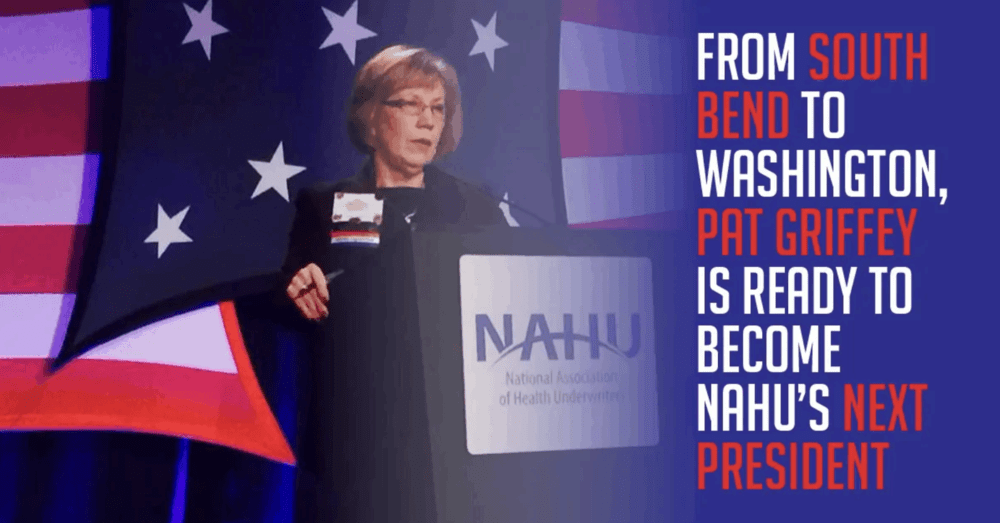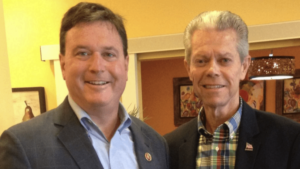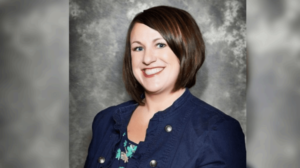Right now, a poll is being released that says Americans support “Medicare for All”. And another is being released saying they don’t. Bernie Sanders is speaking into a microphone saying the healthcare industry is broken. Mike Pence is saying it isn’t. Alexandria Ocasio-Cortez is exuding a level of energy that is shifting media attention. And all the while, a fiercely loyal group of insurance industry professionals in Washington are keeping an eye on everything. One of those
leaders is Pat Griffey, who is heading into her seventh year with the National Association of Health Underwriters in a position of leadership. “A lot happens behind the scenes that a general [NAHU] member doesn’t realize. We’ve had our
eye on this much longer than anyone else has. We’re not surprised,” she says.
At a time when it seemed like the health insurance and healthcare industries might be regaining its footing to a new relative political normalcy since the Affordable Care Act, 2020’s presidential election and more state-level initiatives promise to throw everything up in the air again.
“Everything depends on the political winds, but one of our biggest focuses is on “Medicare for All”. The votes from that caucus are lower this time than last time, so there isn’t as much traction. I hope that’s because we’ve had good PR and comments to legislators before our DC Capitol Conference,” says Griffey.
Political winds increasingly feel like headwinds for everyone and everything in Washington, but long-timers know things have always been this way. Meanwhile, local Health Underwriter chapters are watching their membership rolls wither.
Given this climate, one wonders why anyone would want to take on the part of NAHU’s President this summer. Pat Griffey does not share that same wonder. She’s been preparing for it her entire life.
150 miles from the nearest Association In 1987 Pat Griffey went to work at a small insurance agency in South Bend, Ind. she would later claim as her own with her husband, Don, and rename to Page1Benefits. A new member of NAHU, she was assigned to the Indianapolis Chapter — a group that met monthly 150 miles and two and a half hours away under the best conditions.
Not satisfied with a five-hour round-trip commute to be a member, Griffey partnered with Larry Sanders to start the Greater Northern Indiana Association of Health Underwriters (GNIAHU) in South Bend. From there, her position in leadership was underway.
Within a few years Griffey was serving as Secretary and later Treasurer of the Indiana State Association of Health Underwriters. “I used to joke the only way to get off the State Board is to run for Regional Vice President,” says Griffey with a chuckle. In what would become a recurring pattern in her ascent, Mike Embry left his position as the Region III RVP to run for NAHU Secretary. “Mike asked me if I would consider running for his vacated position,” says Griffey adding, “That was to be a three-year term and lo and behold, we had a resignation on the national board not long after for Treasurer.”
One day at lunch Janet Trautwein, NAHU CEO, looked across the table at a budget meeting and asked Griffey, “Why don’t you run for Treasurer? You have the experience.”
“I had never aspired to run for an Executive Committee position on the national board,” says Griffey. “It was just circumstances, and I continued to follow the path.” With half a decade of experience as ISAHU’s Treasurer and the winds blowing in her favor, Pat Griffey found herself elected as NAHU’s Treasurer in 2016, subsequently elected as Vice President in 2017 and then, last summer, President-Elect.
The rise marks a profound exclamation mark to a career that has included continuing leadership roles in local, state, regional, and national positions since GNIAHU was founded in 1998.
“Hey, Colorado’s doing something”
With more than a glimmer of pride in her voice, Griffey can quickly rattle off a series of accomplishments NAHU has had a hand in recently. “We just introduced – this year – a bill that defines COBRA as credible coverage for those aging into Medicare. This helps people avoid a penalty when it wasn’t considered credible before.” She adds, “We’ve also had success in shining the light on Observation Status so folks don’t have to have a threeday hospital stay before they qualify under Medicare for skilled nursing. And we have deeper roots in CMS now than we’ve had for many years.” In many ways, NAHU may be stronger than it ever has been in getting things done in Washington.
If Griffey seems most passionate about Medicare lately, it’s because she is. “This is a market I’ve worked in since Medicare Advantage products became available in Indiana in 2006. Once members see what our Medicare working
group is accomplishing, they’ll realize we’re strongly committed to fixing some serious problems.” It’s only been in the last two years NAHU has started to flex muscle with Medicare. That strength, Griffey says, is due in large part to John Green, NAHU’s Legislative Lobbyist who is regularly making rounds on the Hill.
Much of the news out of NAHU may come as a surprise to many people in legislatively stable states like Indiana. “Whenever there is a discussion I get to hear it first hand. “Hey, Colorado’s doing something. New York’s got this thing”. I assure you we heard it months ago. We’ve been getting this info fed to us regularly from all over the country from members serving on our Legislative Team and our working groups. We work with all the states, but some require more attention in very specific areas, which is why you don’t hear much about it in Indiana.”
To further prove the point, Griffey can you tell what all the vote totals are for any measure in the country. “We also know what the votes were and we’ve got a gauge on that. We can crank up our efforts surprisingly quick because everyone’s been in the loop from day one.”
To the average agent, most of this information comes daily in the NAHU Newswire email. But in the firehose that is an average person’s inbox, it’s easy to skip. When your state isn’t drawing a lot of attention, it’s even easier to ignore.
NAHU leadership is clearly aware of that. “The Newswire is often overlooked by our members which is unfortunate. What’s happening in New York or California could happen to any other state or happen nationally. It does matter.”
It isn’t 1786 and States do not act in a vacuum unto their own power anymore. And
membership dues to NAHU go to more than just a few lobbyists and salaries. These efforts operate on a national scale to protect and balance an industry’s needs, a market’s forces, and the democratic forces all pushing and pulling on a base of agents, brokers, healthcare providers, and health insurers. “Key people are doing important work. I know what people like Janet Trautwein and John Green have sitting off to the side. I know what’s in their desk drawer. I know they know what’s happening.”
But there are issues surfacing that aren’t just political. It doesn’t matter how vital NAHU’s work is if there are no agents paying dues to support the organization.
“You can call me Pat”
So long as we associate leadership with masculinity, the method for putting highly-qualified, talented, and often better women in positions of authority is inherently broken. Griffey remembers the sentiment of men and women in ’50s when she was growing up, the ’80s when she started her insurance career, and today as she continues her career inside NAHU.
“Growing up I always went by Pat,” she says. “My father chose the name “Patricia”, but my mother believed Pat was too masculine so she called me “Patsy”.” For anyone who has worked with Griffey they know she simply goes by “Pat”, a
name many women may recognize as an astute way of sounding gender-neutral. But, as cultures shift, Griffey’s close friend Carol Cutter encouraged her in 2005 to go by “Patricia” for formal business endeavors.
NAHU has had women in leadership roles as far back as 1956 when the first woman became NAHU President. Griffey will be the seventh in NAHU’s eighty-nine-year history. More recently and broadly, 19% of women were in leadership roles within the insurance industry in 2017. That is an increase from 12% in 2013. A statistical nugget Griffey can cite to you off the top of her head.
At NAHU’s annual Capitol Conference this year in D.C., Griffey, Beth Ashmore, and Eva Jean Fomalant were asked by a moderator what has changed for women since they started their careers. “Before I could answer,” says Griffey, “Beth Ashmore spoke first and said exactly what I would have said: ‘Many of us have kept our nose to the grindstone and just kept doing our job. Consequently, there are now more women which is the biggest change overall for those that are following us.”
“At some point you rise to the top,” says Griffey. “We work differently than men, for sure.” If you asked her several years ago a similar question, her response would have likely mentioned that women “work harder”. “But today I say we work differently,” she says. “When you work alongside women, we multitask well and we easily critique things that might have been missed. But I’m encouraged by the number of women in the industry today.”
“If you can show you can be effective, that’s how you become accepted as a woman in business today. I’ve been blown away by the women in our association that are excited about my presidency.”
A three-legged stool on a big ship
Griffey’s role in NAHU this year will likely depend on NAHU’s ability to do what it has done for nearly ninety years: survive. The problems members are likely to cite against NAHU today seem small compared to what it has navigated in the last ninety years. NAHU came of age less than ten years after women’s suffrage and then endured the Great Depression and WWII, charted passage through presidential assassinations, market recessions and growth, the formation of Medicare and Medicaid, Social Security, the Civil Rights movement, and fifteen presidents since Herbert Hoover was in office in 1930. But certain market forces have not been a problem all at the same time until today.
“This association was built on a small agency. I can’t argue that point,” says Griffey. Small agencies have powered the nation’s healthcare coverage system for generations. “That’s changed and the pace has picked up in 2019 even from two years ago. We have to realize if we stay with that one or two-member shop, we’re dead on the vine,” she says.
Like any large enterprise, it takes time to right the ship. And while you’re waiting for it to turn you will likely face a few waves. “For eighteen months we’ve been working on the agency dues model that will deliver the benefits that attract larger agencies, while also working to maintain the small agency standards we established over our long history” says Griffey. NAHU will begin touting this new business model and its benefits for the large agency in a few months.
If keeping an eye on the growing and contracting “Medicare for All”
movement is the first leg of a three-legged stool Griffey is shepherding into
production, then agency dues and membership benefits is second.
Even before Griffey joined NAHU’s Executive Committee three years ago they recognized a shrinking in their communities due to mergers and acquisitions and the increasing age of NAHU members. “A small group of us began to put our minds together: what if instead of 20,000 members,we’re really an association of 15,000? Or 14,000? How do we handle
that?”
Market forces that have consolidated many small shops into larger agencies have been slow to come for the Medicare market. “We’re missing a huge opportunity on the Medicare side for the small one or two-person shops. That is being addressed by the Futures Task Force. For all we know our true number of individual members might be 14–15,000. But that’s not something we can control,” she says. To grow further, “We address that by attracting larger agencies for a flat fee that delivers unique benefits specific to their market and designing new programs for the single Medicare agents and those who work in the individual market space.”
The Futures Task Force is the third leg of the stool. Originally set up last July under Rusty Rice, NAHU has been looking to transform into an organization that is proactive on legislation instead of reactive. The futures task force is charged with charting a path to make it happen.
Some of NAHU’s priorities under this Futures Task Force is in the arena of attracting new employees, providing new technology, and working with millennials. All items so broad in scope and demands Griffey says “It was difficult to pull it into a workable outline, which now is being done by the Futures Task Force”
If NAHU can succeed in covering significant ground in becoming proactive, winning in new members through larger consolidated agencies, and keeping a finger tuned to the political winds, 2020 could mark the beginning of NAHU’s most successful chapter.
“I don’t have a specific agenda,” says Griffey. But she does have other smaller goals related to communication and NAHU’s awards program.
She remembers what it was like leading GNIAHU and how the game of telephone played between NAHU, regional, state, and local chapters is slow and distorts essential details. “We’re trying to fix that. It’s amazing how many times people say we took a position, but it’s not always accurate,” she says.
For state and local chapters raising eyebrows at NAHU’s annual awards criteria, a method for chapters to earn recognition and status by performing NAHU-requested tasks, Griffey sees some room for improvement. “I’m not a proponent of awards for the sake of awards. We’re in the process of making changes in how points are developed,” she says.
Specifically, Chapters may soon have a way to earn “credit” for something other than a monthly meeting, a practice that many chapters find ever more challenging to get people to attend as CE comes freely in the workplace, online, and work schedules get tighter. “I applaud the chapters still keeping things open, but we need to make sure we’re focusing on the right things,” she says.
A source of knowledge
After this coming year as President, Griffey will remain with NAHU as the Immediate Past-President, for one year, a role that guarantees NAHU an immense encyclopedia of institutional and industry knowledge. “Then it’s up to me,” she says with a smile. “It’s no secret I’m on the back end of my career.”
Some NAHU leaders continue to stick around on the national board for
many years after their time in a leadership term passes. Some, like Texas’ Beth Ashmore, return to state or local levels as advisors. Griffey isn’t ruling it out, but she sounds more comfortable continuing to lead the entire industry at the national level in Washington. “I’m not a big fan of going backwards if it’s not going to help.”






